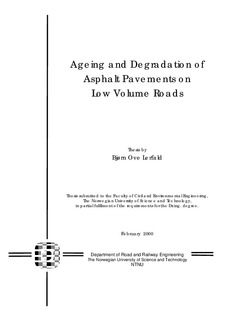| dc.description.abstract | An important objective with this research work has been to get more knowledge about mix design and maintenance of low volume roads with asphalt pavements in Norway.
A literature review on bitumen, filler, rheology and ageing has been carried out. This has been focused on bitumen and filler because of their importance in the asphalt mixture. Bitumen as the binder in the asphalt pavement, and filler because of its relatively large surface area compared to the rest of the aggregates. Filler will therefor have a relatively large contact area to the bitumen and hence is important for the properties of the bitumen as binder in the pavement.
An investigation on deterioration of asphalt pavements on low volume roads in Norway has been carried out. The most frequent types of distress found on these roads were; edge cracks, cracks due to frost heave, rutting, transverse cracks and ageing. It is difficult to classify ageing as a type of distress, but the ageing process influences several pavement properties. The service life of an asphalt pavement on low volume roads is highly dependent on the ageing properties of the binder. An important challenge in pavement maintenance and mix-design is to find a proper binder and asphalt mixture according to local conditions, such as temperature, structure conditions and bearing capacity.
An important factor contributing to the ageing process in the field is the climate. In this work, samples from two different climatic zones have been analysed. Mechanical studies of asphalt core samples were performed. In addition recovered binder from the asphalt core samples and laboratory aged binder were studied. Both SHRP binder specification tests and conventional tests have been used in the analyses of the binder. In this investigation it was found that the age hardening of the bitumen is most severe in the upper part of the pavement and decrease with depth. Another important conclusion from this part of the study is that climatic conditions should be taken into account in a more comprehensive way than today when choosing binder for asphalt pavement.
It is well known that a relative great part of the age hardening of bitumen occurs during production, transportation and paving. An investigation on two transports with freighter was performed, to investigate the magnitude of age hardening of bitumen during long transportation (15 – 50 hours). The temperature was measured in three
levels of the load in one of the transports. The temperature 0,5 m from the top and 0,5 m from the bottom of the load decreases by 1,2°C/hour and 1,34°C/hour, respectively. The temperature almost remaind constant in the core of the asphalt mixture. After a long transportation it is recommended to mix the asphalt from different levels in the load. This is due to the fact that the compaction temperature will differ significantly when taking the asphalt mixture directly from the load without any mixing. High and varying void content in the pavement could be the result when the compaction temperature is varying and sometimes is to low. Another finding from this investigation was that the hardening during transportation seems to be dependent upon type of binder. The long transportation does not seem to contribute excessive hardening of Pen180, while MB10000 (soft binder) did harden significantly during transportation.
Because the surface area of the filler material in an asphalt mixture represents a major part of the total surface area of the aggregate, a study of how different types of fillers affect the rheological and ageing properties of filler-bitumen mixes has been conducted. Four different types of fillers where used, among them hydrated lime, which is claimed to have positive influence on the ageing properties of binders. Two types of binder were used in the study. The analyses were carried out using test equipment according to the SHRP binder specification.
Based on the result from this investigation some main conclusions are:
• When producing filler-bitumen mixes of equal stiffness, the “effective filler concentration concept”, based on Rigden void content seems to correlate to the high temperature stiffness. At low temperatures (-20/-25°C) and intermediate temperatures (10 - 30°C) however, these mixtures were found to vary in stiffness.
• Based on BBR and DTT measurements of filler-bitumen mixes, the net effect of hydrated lime on low temperature cracking properties seems to be very small.
• No clear variation in ageing properties for mixes containing different types of fillers can be seen. However, there seems to be some variations between the two types of binders used in the investigation.
• The void content in the filler is an important factor, which should be evaluated in the asphalt mix-design in a more comprehensive way than today.
• The SHRP-binder equipment seems to be a step forward in evaluating the properties of filler-bitumen mixes. | nb_NO |
